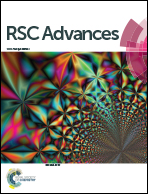Cobalt oxide nanoparticles embedded in flexible carbon nanofibers: attractive material for supercapacitor electrodes and CO2 adsorption†
Abstract
Introducing flexibility and high porosity into carbon nanofibers (CNFs) is one of the critical challenges for the next generation of multifunctional energy storage and CO2 adsorption materials. Herein, we developed an efficient strategy for the controllable fabrication of a flexible and mechanically robust Co3O4 nanoparticles (NPs) doped CNFs (CNFs-Co) hybrid membrane via electrospinning and subsequent carbonization treatment. The quantitative pore size distribution and fractal analysis revealed that the CNFs-Co possessed a tunable porous structure with high surface area of 483 m2 g−1. Therefore, it exhibited exceptional performance in CO2 capture, i.e. a high CO2 adsorption capacity of 5.4 mmol g−1 at 1 bar and room temperature. Electrochemical measurements performed on CNFs-Co for supercapacitor applications demonstrated very high capacitance of up to ∼911 F g−1 at 5 mV s−1 (76% capacitance retention after 1000 cycles) in 1 M H2SO4 solution. The successful synthesis of this hybrid membrane may also provide new insights towards the development of materials for various multifunctional applications.


 Please wait while we load your content...
Please wait while we load your content...